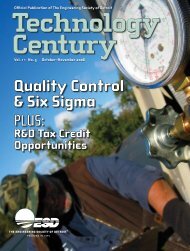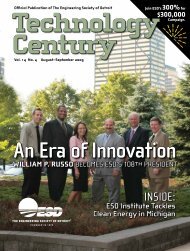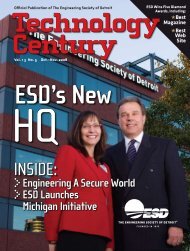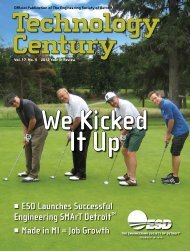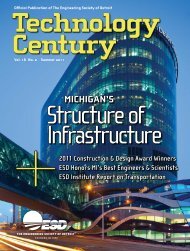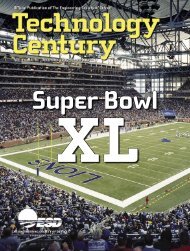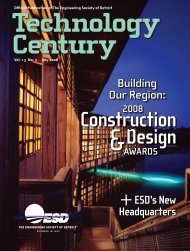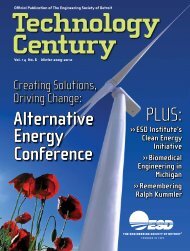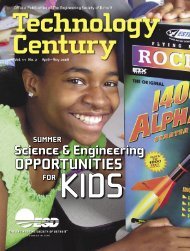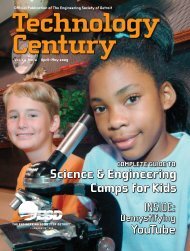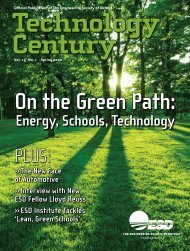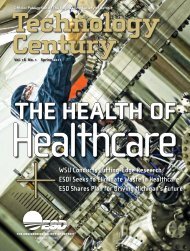Download - ESD
Download - ESD
Download - ESD
- No tags were found...
Create successful ePaper yourself
Turn your PDF publications into a flip-book with our unique Google optimized e-Paper software.
One of the major challenges that still needs to be addressed<br />
is copyright management. Content owners such as The<br />
Walt Disney Company and Sony BMG are understandably<br />
concerned about the possibility of copies of their music and<br />
video programs being freely available over the Internet. As<br />
a result, they are reluctant to agree to allow their content to<br />
be moved from computer to computer or from computer to<br />
vehicle. Microsoft, Apple Computer and others have begun to<br />
address this problem in the context of portable music players.<br />
The solutions currently available, however, are incompatible<br />
with each other and, generally, haven’t been extended to<br />
video content.<br />
Service, safety and mobility<br />
Of course, the use of the wireless data link is not limited to<br />
just entertainment functions. Once the necessary hardware<br />
has been installed in the vehicle, it can be used for many other<br />
applications. For example, it is possible to transfer diagnostic<br />
data over the wireless network. Using such an application, it<br />
would be feasible to pull the diagnostic trouble codes from your<br />
vehicle, look up their interpretations on the Internet and then<br />
schedule an appointment with a dealer—all without leaving<br />
home. Alternatively, if you chose to take your vehicle to the<br />
dealer first, the diagnostic codes could be downloaded from<br />
your vehicle and a preliminary repair estimate prepared as<br />
you walk from the parking area to the service desk. Another<br />
interesting application is “drive-by inspections.” In this case,<br />
your vehicle’s emissions subsystems could be queried for<br />
proper operation by roadside equipment. If there are no<br />
problems, then your inspection sticker is automatically<br />
renewed without the need to visit an official inspection station.<br />
Vehicle-infrastructure integration (VII) has the potential<br />
to have a more significant impact on our driving experience than<br />
any other wireless application. VII is a joint effort between<br />
the U.S. Department of Transportation and the automotive<br />
manufacturers to use wireless communications to improve<br />
highway safety and traffic flow. The proposed primary<br />
communications link is a variation of 802.11, known as<br />
IEEE 802.11p, or wireless access for the vehicle environment<br />
(WAVE). As currently envisioned, the system will allow<br />
vehicles to exchange critical information with each other<br />
and with roadside infrastructure. Currently, over 100 potential<br />
applications have been identified including:<br />
• Warning when approaching stopped or slowed traffic<br />
too quickly;<br />
• Warning about upcoming congestion and providing an<br />
alternate route;<br />
• Highway merge assistance;<br />
• Automated vehicle collision avoidance maneuvering; and<br />
• Dynamic traffic signal phasing to optimize traffic flow.<br />
It is anticipated that a few high priority VII applications<br />
will be developed and tested over the next 2 to 3 years, and a<br />
decision whether or not to deploy the network will be made<br />
in 2008. If the decision is positive, the initial nationwide<br />
deployment should be completed sometime in 2011 or 2012.<br />
AUTOMOTIVE FUTURE<br />
With all of the wireless network development being completed<br />
by the automotive industry—Delphi and others—it is inconceivable<br />
that the vehicle of the future will not include some<br />
form of wireless data communication. Timing and the specific<br />
applications are still open questions, but it seems that entertainment<br />
applications will likely be implemented first, followed by<br />
service, safety and mobility applications.<br />
References<br />
1. “Multiplex Bus Progression,” C. Lupini, SAE paper 2003-01-<br />
0111.<br />
2. “Vehicle Multiplex Communication,” C. Lupini, SAE publication<br />
R-3 40.<br />
Christopher A. Lupini is Lead Engineer for<br />
the Delphi Serial Data Center of Expertise at<br />
Delphi Electronics & Safety. He has worked<br />
in the data communications industry for<br />
18 years and has been consulting and teaching<br />
for 12 years. Past accomplishments include<br />
assisting in the design and development of<br />
the General Motors Class 2 and GMLAN<br />
protocols, as well as specifying and testing numerous J1850 and CAN<br />
ICs. Mr. Lupini has one patent and has authored a dozen technical<br />
papers and articles, as well as a textbook.<br />
Douglas L. Welk leads a group of engineers<br />
who develop advanced vehicle-based<br />
applications for a variety of wireless data<br />
networks at Delphi Corporation. He has<br />
over 15 years of experience developing<br />
vehicle-based entertainment and<br />
information electronics. Past projects<br />
include FM-Radio Data System (FM-RDS)<br />
receivers and navigation systems. Mr. Welk has authored several<br />
technical papers on, and has several patents and intellectual<br />
property disclosures in, the areas of navigation, information and<br />
entertainment systems.<br />
www.esd.org | The Engineering Society of Detroit | 25



